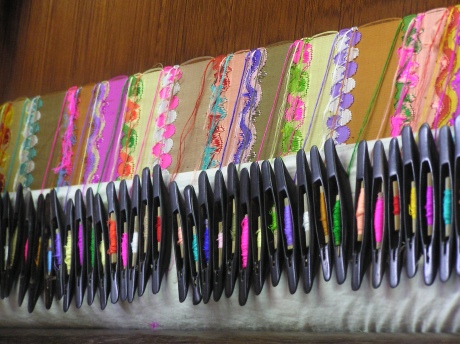|
Eine Seidenspinnerei ist ein
faszinierender Ort, an dem der Prozess der Seidenherstellung –
vom Kokon zum fertigen Stoff – beobachtet werden kann. In Myanmar,
insbesondere in der Region um Mandalay und Inle
Lake, gibt es mehrere Seidenspinnereien, die Besuchern einen
Einblick in dieses traditionelle Handwerk bieten. Die Seidenherstellung
hat in Myanmar eine lange Geschichte und ist ein wichtiger Teil der
lokalen Kultur und Wirtschaft.
Der Prozess der Seidenherstellung:
-
Seidenraupenzucht:
-
Die Seidenraupen werden gezüchtet und mit Maulbeerblättern gefüttert,
ihrer Hauptnahrungsquelle.
-
Nach etwa einem Monat spinnen die Raupen Kokons aus Seidenfäden.
-
Kokons verarbeiten:
-
Die Kokons werden in heißem Wasser eingeweicht, um die
Seidenfäden zu lösen.
-
Die Fäden werden dann vorsichtig abgewickelt und zu einem
einzigen, starken Faden zusammengedreht.
-
Färben und Weben:
-
Fertige Produkte:
-
Die fertigen Seidenstoffe werden zu Kleidung, Schals, Tüchern
und anderen Textilien verarbeitet.
-
Myanmar-Seide ist bekannt für ihre hohe Qualität und lebendigen
Farben.
Seidenspinnereien in Myanmar:
-
Inle Lake:
-
Am Inle Lake gibt es mehrere Seidenspinnereien, die Besuchern
den gesamten Herstellungsprozess zeigen.
-
Die Seide wird hier oft mit traditionellen Mustern und Techniken
verziert.
-
Amarapura (bei Mandalay):
-
Amarapura ist ein Zentrum der Seidenherstellung in Myanmar. Hier
können Besucher die gesamte Produktionskette von der
Kokonverarbeitung bis zum Weben beobachten.
-
Die Stadt ist auch für ihre U-Bein-Brücke und
ihre Seidenmärkte bekannt.
-
Mandalay:
Warum eine Seidenspinnerei besuchen?
-
Kulturelles Erbe: Die Seidenherstellung ist ein
traditionelles Handwerk, das tief in der Kultur Myanmars verwurzelt
ist.
-
Einzigartige Souvenirs: Besucher können hochwertige
Seidenprodukte wie Schals, Tücher und Kleidung direkt vor Ort
kaufen.
-
Bildungserlebnis: Der Besuch einer Seidenspinnerei
bietet einen faszinierenden Einblick in einen komplexen und
arbeitsintensiven Prozess.
Tipps für Ihren Besuch:
-
Fragen Sie nach einer Führung, um den gesamten Prozess von der
Kokonverarbeitung bis zum Weben zu verstehen.
-
Unterstützen Sie lokale Handwerker, indem Sie Seidenprodukte direkt
in der Spinnerei kaufen.
-
Kombinieren Sie Ihren Besuch mit anderen Sehenswürdigkeiten in der
Region, wie dem Inle Lake, der U-Bein-Brücke oder
den Pagoden von Mandalay.
Ein Besuch in einer Seidenspinnerei ist nicht nur ein kulturelles
Highlight, sondern auch eine Gelegenheit, die handwerkliche Tradition
Myanmars zu unterstütze
Seidenspinnerei refers to a
silk spinning mill or
silk factory in German.
It is a place where raw silk
fibers are processed into silk thread or fabric. The process of
silk production involves several stages, from the harvesting of silk
from
silkworms to the spinning and weaving of the fibers into
textiles.
Key Aspects of
Seidenspinnerei (Silk
Spinning Mill):
-
Silk Production Process:
- The process starts with the
silkworm (Bombyx
mori) which spins its cocoon made of a long silk
thread.
-
Silk farmers
harvest the cocoons and boil them to soften the sericin, a
protein that holds the silk fibers together, making them easier
to unspool.
- The long threads are then
carefully unwound from the cocoon, spun into
silk thread,
and sometimes dyed before being woven into fabric.
-
Silk Spinning and Weaving:
- In a
Seidenspinnerei,
the raw silk threads are spun into finer yarns. This process may
involve the use of
spinning machines or traditional manual methods.
- Once the silk thread is
spun, it can be woven into a wide range of fabrics such as
silk brocade,
silk chiffon,
or silk satin.
- Some
Seidenspinnerei
establishments may specialize in high-quality silk products like
scarves,
ties, or
luxurious garments.
-
Historical Significance:
- Silk production has a long
history, dating back thousands of years, particularly in
China and
later in other parts of
Asia and
Europe.
- In Europe, especially
during the 17th and
18th centuries, silk mills or
Seidenspinnereien
were important industrial establishments, particularly in places
like France,
Italy, and
Germany.
- In the
Industrial Revolution,
silk mills became highly mechanized, leading to the mass
production of silk goods for both local markets and export.
-
Economic Importance:
- Silk mills, including
Seidenspinnereien,
were crucial for the local economy during their peak. They
provided jobs for many workers, from the labor-intensive tasks
of silkworm farming to the technical aspects of spinning and
weaving silk.
- In modern times, while
silk spinning mills
still exist, many have been replaced by advanced technologies
and synthetic fibers. However, traditional mills may still
operate in places where artisan silk production is highly
valued.
-
Cultural Impact:
- Silk is a highly prized
fabric known for its luxurious feel, sheen, and softness.
Seidenspinnerei
represents an important part of
textile history,
especially in countries that have a long tradition of
silk weaving
and the production of silk-based goods.
- In some regions, the
tradition of silk spinning continues today, with the craft being
passed down through generations and celebrated for its cultural
significance.
Conclusion:
A Seidenspinnerei is
a fascinating place that reflects the historical and ongoing process of
silk production. It
is where the transformation of
silk fibers from nature into luxurious, finely spun threads and
fabric takes place, contributing to the legacy of one of the most
coveted and elegant materials in the world. Whether in a traditional,
artisanal setting or a modern industrial mill, the art of
silk spinning remains
an important cultural and economic activity in many parts of the world.
|
|
 Safaris
Bergsteigen
Wandern
Inselwandern Weltweit
Safaris
Bergsteigen
Wandern
Inselwandern Weltweit
 Europa
Inselwandern
Europa
Inselwandern
 Städtewandern
Städtewandern
 Paintings
Paintings Dirk Rauschenbach
Dirk Rauschenbach
 Safaris
Bergsteigen
Wandern
Inselwandern Weltweit
Safaris
Bergsteigen
Wandern
Inselwandern Weltweit
 Europa
Inselwandern
Europa
Inselwandern
 Städtewandern
Städtewandern
 Paintings
Paintings Dirk Rauschenbach
Dirk Rauschenbach

![]() 26.07.25 Copyright Dirk
Rauschenbach Koelnerstrasse 293 51702 Bergneustadt
Datenschutzerklaerung 02261 9788972 Mail ccooly(
at) web.de
26.07.25 Copyright Dirk
Rauschenbach Koelnerstrasse 293 51702 Bergneustadt
Datenschutzerklaerung 02261 9788972 Mail ccooly(
at) web.de